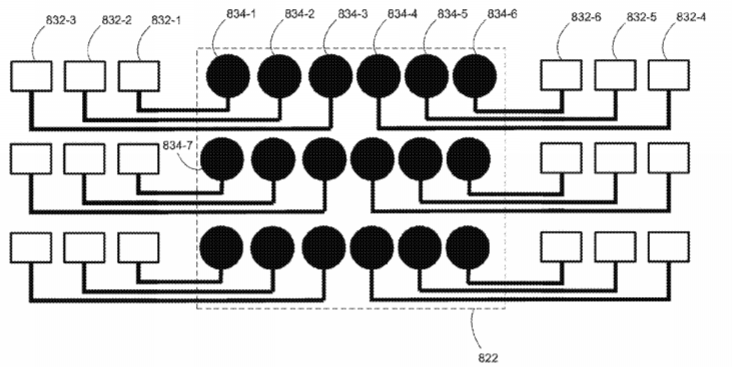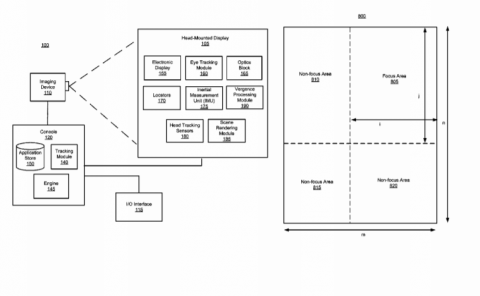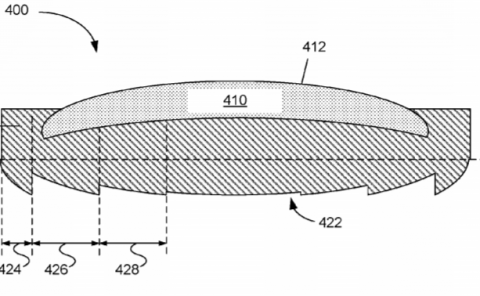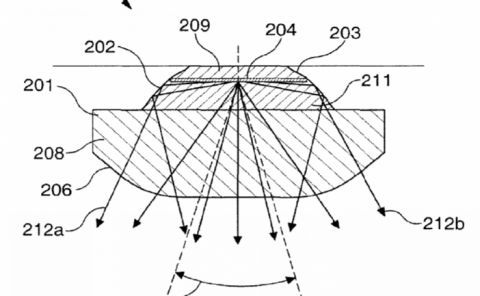Facebook Patent | Enhanced Spatial Resolution Using A Segmented Electrode Array
Patent: Enhanced Spatial Resolution Using A Segmented Electrode Array
Publication Number: 10670929
Publication Date: 20200602
Applicants: Facebook

Abstract
A light intensity modulator array includes a first substrate with a two-dimensional array of electrodes; a second substrate with one or more electrodes; and liquid crystal located between the first substrate and the second substrate. The two-dimensional array of electrodes is arranged in a first direction and a second direction that is not parallel to the first direction. A respective electrode of the two-dimensional array of electrodes is distinct and separate from a first adjacent electrode and a second adjacent electrode of the two-dimensional array of electrodes. The first adjacent electrode is adjacent to the respective electrode in the first direction and the second adjacent electrode is adjacent to the respective electrode in the second direction. A method for tracking an eye using a device including the light intensity modulator array is also disclosed.
TECHNICAL FIELD
This relates generally to display devices, and more specifically to head-mounted display devices.
BACKGROUND
Head-mounted display devices (also called herein head-mounted displays) are gaining popularity as means for providing visual information to user. In a head-mounted display, when worn by a user, optical elements (e.g., displays) are located close to one or more eyes of the user. Due to the proximity of such optical elements to eyes of the user, the size of pixels in the optical elements has presented various challenges. For example, when pixels of a conventional size are located away from an eye, spacing between the pixels may not be visible. However, when the same-size pixels are located close to the eye, the spacing between pixels becomes more visible, which reduces the quality of user experience.
SUMMARY
Accordingly, there is a need for high spatial resolution optical elements (e.g., displays), thereby making the spacing between the pixels less visible and enhancing the user’s virtual-reality and/or augmented reality experience. In addition, high spatial resolution optical elements can be used in eye trackers for improving angular and/or spatial resolution of the eye trackers.
The above deficiencies and other problems associated with conventional optical elements are reduced or eliminated by the disclosed optical elements. In some embodiments, the disclosed optical elements are used in a head-mounted display device. In some embodiments, such optical elements are used in a portable device.
In accordance with some embodiments, a light intensity modulator array includes a first substrate with a two-dimensional array of electrodes; a second substrate with one or more electrodes; and liquid crystal located between the first substrate and the second substrate. The two-dimensional array of electrodes is arranged in a first direction and a second direction that is not parallel to the first direction. A respective electrode of the two-dimensional array of electrodes is distinct and separate from a first adjacent electrode and a second adjacent electrode of the two-dimensional array of electrodes. The first adjacent electrode is adjacent to the respective electrode in the first direction and the second adjacent electrode is adjacent to the respective electrode in the second direction.
In accordance with some embodiments, a device includes any light intensity modulator array described herein, and one or more light sources.
In accordance with some embodiments, a method for tracking an eye of a user includes initiating one or more light sources to emit light. The light from the one or more light sources is transmitted toward the eye of the user. The method also includes initiating the one or more detectors of the device to detect the light reflected from the eye of the user with the one or more detectors.
Thus, the disclosed embodiments provide high spatial resolution optical elements, which increases user satisfaction with such devices.
BRIEF DESCRIPTION OF THE DRAWINGS
For a better understanding of the various described embodiments, reference should be made to the Description of Embodiments below, in conjunction with the following drawings in which like reference numerals refer to corresponding parts throughout the figures.
FIG. 1 is a perspective view of a display device in accordance with some embodiments.
FIG. 2 is a block diagram of a system including a display device in accordance with some embodiments.
FIG. 3A is an isometric view of an adjustable electronic display element of a display device in accordance with some embodiments.
FIG. 3B is a partial cross-sectional view of the adjustable electronic device in accordance with some embodiments.
FIG. 3C is a perspective view of a tile in accordance with some embodiments.
FIG. 3D is a perspective view of a portion of the adjustable electronic display element in accordance with some embodiments.
FIGS. 3E-3G are schematic diagrams illustrating an exemplary operation of tiles in accordance with some embodiments.
FIGS. 3H and 3I are schematic diagrams illustrating exemplary operations of activating a subset of tiles in accordance with some embodiments.
FIGS. 4A and 4B illustrate prophetic examples of correcting brightness variations in accordance with some embodiments.
FIG. 5 is a flow diagram illustrating a method of activating a subset of a two-dimensional array of tiles of a display device in accordance with some embodiments.
FIG. 6A is a schematic diagram illustrating a lens assembly in accordance with some embodiments.
FIG. 6B is a zoomed-in view of the lens assembly shown in FIG. 6A.
FIG. 6C is a perspective view of a two-dimensional array of tiles in accordance with some embodiments.
FIGS. 7A and 7B are schematic diagrams illustrating back reflection of light entering an eye in accordance with some embodiments.
FIG. 7C is a graph representing intensity of light reflected by an eye in accordance with some embodiments.
FIGS. 7D-7F are schematic diagrams illustrating methods of determining a location of a pupil in accordance with some embodiments.
FIG. 7G is a perspective view of a portion of a two-dimensional array of tiles in accordance with some embodiments.
FIG. 7H is a schematic diagram of a display device in accordance with some embodiments.
FIG. 7I is a schematic diagram of a display device in accordance with some embodiments.
FIG. 7J is a timing diagram illustrating an operation of an eye tracker in accordance with some embodiments.
FIG. 8A is a schematic diagram illustrating a cross-sectional view of a conventional liquid crystal panel in accordance with some embodiments.
FIG. 8B is a schematic diagram illustrating a plan view of a conventional liquid crystal panel in accordance with some embodiments.
FIG. 8C is a schematic diagram illustrating a cross-sectional view of a high spatial resolution panel in accordance with some embodiments.
FIG. 8D is a schematic diagram illustrating a plan view of electrodes in a high spatial resolution panel in accordance with some embodiments.
FIG. 8E is a schematic diagram illustrating a plan view of electrodes in a high spatial resolution panel in accordance with some embodiments.
FIG. 8F is a schematic diagram illustrating a cross-sectional view of a high spatial resolution display device in accordance with some embodiments.
FIG. 8G is a schematic diagram illustrating a cross-sectional view of a high spatial resolution detector in accordance with some embodiments.
FIG. 8H is a schematic diagram illustrating a cross-sectional view of a high spatial resolution display device in accordance with some embodiments.
These figures are not drawn to scale unless indicated otherwise.
DETAILED DESCRIPTION
Conventional head-mounted displays are larger and heavier than typical eyeglasses, because conventional head-mounted displays often include a complex set of optics that can be bulky and heavy. It is not easy for users to get used to wearing such large and heavy head-mounted displays.
The disclosed embodiments, by utilizing a combination of a pixel array and a microlens (called herein a “tile”), provide display devices (including those that can be head-mounted) that are compact and light. In addition, display devices with an array of tiles can provide a large field of view, thereby improving user experience with the display devices.
Reference will now be made to embodiments, examples of which are illustrated in the accompanying drawings. In the following description, numerous specific details are set forth in order to provide an understanding of the various described embodiments. However, it will be apparent to one of ordinary skill in the art that the various described embodiments may be practiced without these specific details. In other instances, well-known methods, procedures, components, circuits, and networks have not been described in detail so as not to unnecessarily obscure aspects of the embodiments.
It will also be understood that, although the terms first, second, etc. are, in some instances, used herein to describe various elements, these elements should not be limited by these terms. These terms are used only to distinguish one element from another. For example, a first tile could be termed a second tile, and, similarly, a second tile could be termed a first tile, without departing from the scope of the various described embodiments. The first tile and the second tile are both tiles, but they are not the same tile.
The terminology used in the description of the various described embodiments herein is for the purpose of describing particular embodiments only and is not intended to be limiting. As used in the description of the various described embodiments and the appended claims, the singular forms “a,” “an,” and “the” are intended to include the plural forms as well, unless the context clearly indicates otherwise. It will also be understood that the term “and/or” as used herein refers to and encompasses any and all possible combinations of one or more of the associated listed items. It will be further understood that the terms “includes,” “including,” “comprises,” and/or “comprising,” when used in this specification, specify the presence of stated features, integers, steps, operations, elements, and/or components, but do not preclude the presence or addition of one or more other features, integers, steps, operations, elements, components, and/or groups thereof. The term “exemplary” is used herein in the sense of “serving as an example, instance, or illustration” and not in the sense of “representing the best of its kind.”
FIG. 1 illustrates display device 100 in accordance with some embodiments. In some embodiments, display device 100 is configured to be worn on a head of a user (e.g., by having the form of spectacles or eyeglasses, as shown in FIG. 1) or to be included as part of a helmet that is to be worn by the user. When display device 100 is configured to be worn on a head of a user or to be included as part of a helmet, display device 100 is called a head-mounted display. Alternatively, display device 100 is configured for placement in proximity of an eye or eyes of the user at a fixed location, without being head-mounted (e.g., display device 100 is mounted in a vehicle, such as a car or an airplane, for placement in front of an eye or eyes of the user).
In some embodiments, display device 100 includes one or more components described below with respect to FIG. 2. In some embodiments, display device 100 includes additional components not shown in FIG. 2.
FIG. 2 is a block diagram of system 200 in accordance with some embodiments. The system 200 shown in FIG. 2 includes display device 205 (which corresponds to display device 100 shown in FIG. 1), imaging device 235, and input interface 240 that are each coupled to console 210. While FIG. 2 shows an example of system 200 including one display device 205, imaging device 235, and input interface 240, in other embodiments, any number of these components may be included in system 200. For example, there may be multiple display devices 205 each having associated input interface 240 and being monitored by one or more imaging devices 235, with each display device 205, input interface 240, and imaging devices 235 communicating with console 210. In alternative configurations, different and/or additional components may be included in system 200. For example, in some embodiments, console 210 is connected via a network (e.g., the Internet) to system 200 or is self-contained as part of display device 205 (e.g., physically located inside display device 205). In some embodiments, display device 205 is used to create mixed reality by adding in a view of the real surroundings. Thus, display device 205 and system 200 described here can deliver virtual reality, mixed reality, and augmented reality.
In some embodiments, as shown in FIG. 1, display device 205 is a head-mounted display that presents media to a user. Examples of media presented by display device 205 include one or more images, video, audio, or some combination thereof. In some embodiments, audio is presented via an external device (e.g., speakers and/or headphones) that receives audio information from display device 205, console 210, or both, and presents audio data based on the audio information. In some embodiments, display device 205 immerses a user in a virtual environment.



